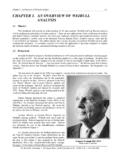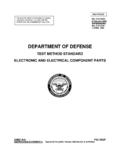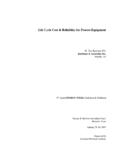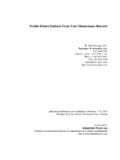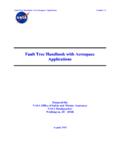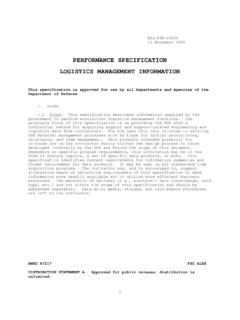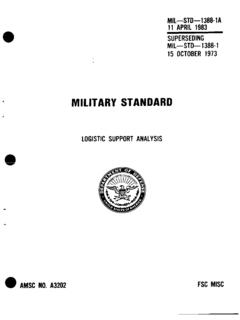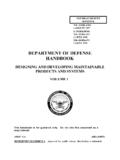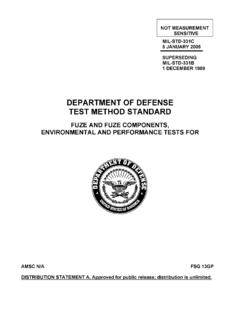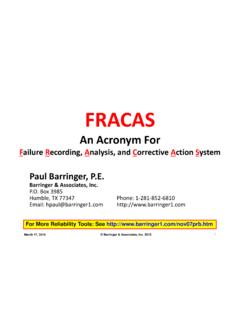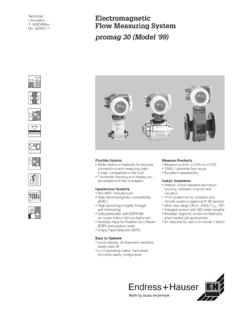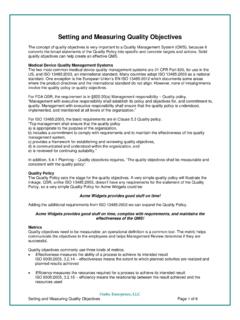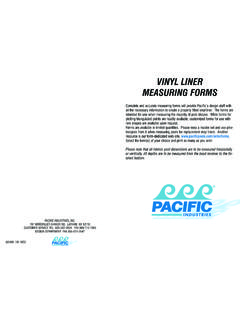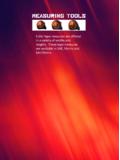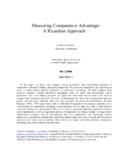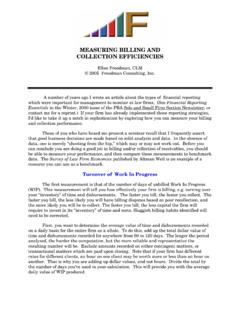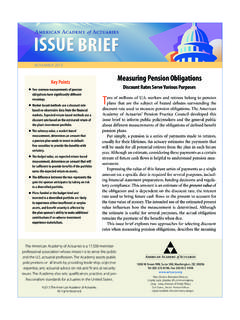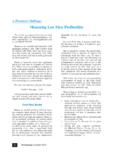Transcription of INSTRUMENTS AND MEASURING DEVICES - …
1 R INSTRUMENTS AND MEASURING DEVICES . section, may be defined as changes of distance between two points belonging to the same solid body. One of the points in a displacement is a moving point and the other is a fixed reference point. An example of such a displacement of interest in CHAPTER IV fatigue testing is the extension of a coil spring, where one end is displaced and the other is fixed to the framework. Another quantity ofinterest is the INSTRUMENTS AND MEASURING DEVICES amplitude of vibration. The amplitude is, in fact, a difference between two displacements of the same point at different times in relation to a fixed point, and may be obtained as the result of two displacement measurements, SECTION 40. GENERAL but there are also methods of eliminating the fixed point and MEASURING the amplitude directly without defining a reference point.
2 The present Chapter will be limited to INSTRUMENTS and DEVICES of specific Displacements and amplitudes of vibration may be measured by means of interest in fatigue testing, and will not include INSTRUMENTS for general mechanical, electrical, optical, acoustical, and pneumatic DEVICES . purposes, even if actually used in fatigue experiments. This means that the A thorough review including all types of INSTRUMENTS for MEASURING measurement of variable quantities will be the main point. The complete displacements is presented by Huggenberger and Sehwaigerer in the hand- information about a variable quantity consists of a record of the time curve, book by SIEBEL (1958). but in many cases it may suffice to measure a maximum, minimum or meap Reference: SIEBEL (1958, 379 395).
3 Value, sometimes with the addition of a frequency, assuming the curve to be sinusoidal. Lack ofspace prevents giving a detailed description of the varions Mechanical INSTRUMENTS and DEVICES INSTRUMENTS , but references to such information and examples of actual A frequently used, simple instrument for MEASURING displacements is applications will be given. the mechanical dial gauge with ranges from 5 to 50 mm and an accuracy of INSTRUMENTS and DEVICES may be classified according to many different from 1 to 20 > < l0~ mm. Another simple device is the micrometer screw. principles, but the attitude taken here will be the same as indicated in the It may be mentioned that the accuracy of this simple tool can be considerably preceding chapter, namely, that of the investigator who knows his specific improved by indicating electrically the contact between the anvil of the purpose and wishes to find out what means will he the best for him to use.
4 Screw and the metallic object to he measured by means of a micro-ammeter From this starting-point, the first-order division will be based on the or a neon lamp which glows when a circuit is completed. Accuracies better quantity which has to be measured, a displacement, a load, etc., and the than l0~ are easily obtained. Still greater accuracy can be attained by a second-order division will be based on the design characteristic, mechani- purely mechanical device used in the proving ring for MEASURING static loads cal, electrical, optical, etc. (cf. Section 43): a vibrating reed consisting of a thin strip with a small mass The present chapter will be divided into the following Sections: (40) attached to its free end is set vibrating by hand; when the anvil ofthe screw General; (41) Displacement- MEASURING INSTRUMENTS and DEVICES ; (42).
5 Makes a very slight touch on the object, a typical sound is heard and the Strain- MEASURING INSTRUMENTS and DEVICES ; (43) Load- MEASURING instru- damping ofthe reed is considerably increased. The amplitude should decline ments and DEVICES ; (44) Stress- MEASURING INSTRUMENTS and DEVICES ; (45) from ~ in. to zero in 2 or 3 seconds. The accuracy will then be about 0~25. INSTRUMENTS and DEVICES for determining surface conditions; (46) Instru- to 0~50 x l0 ~mm. ments and DEVICES for detecting cracks, flaws, and inhomogeneities; (47) The reed gauge, designed primarily for determining static loads by means INSTRUMENTS and DEVICES for counting numbers of stress cycles. of the proving ring, may nlso be used for recording the peak response to a Each Section is subdivided into paragraphs according to design features.
6 Transient motion of systems of single degrees of freedom as described by Comprehensive reviews and accounts of various INSTRUMENTS and methods RUnIN (1958). ~llie recorded data permit the calculation of peak response will be found in the books mentioned below. in each vibrational mode of a complex structure. An upper bound to the References: PFLIER (1940), RODERT5 (1946), SIEnEL (1958). maximum structural response can be obtained by summing the peak SECTION 41. DISPLACEMENT- MEASURING responses in each of the modes. The error thus introduced is in many cases INSTRUMENTS AND DEVICES of small significance. The micrometer can be used not only to measure displacements and General amplitudes of vibrations bitt also for pre-setting and maintaining constant Displacements , which will be the subject of the present section, may be amplitudes of vibrations within narrow limits, as has been successfully defined as changes of distance between two points belonging to different practised by DOLAN (1951).
7 Objects, whereas strains , which will be the subject of the subsequent References: DOLAN (1951), RUBIN (1958), NBS Circ. 454. 66 6 67. FATIGUE TESTING AND ANALYSIS OF RESULTS INSTRUMENTS AND MEASURING DEVICES . Electrical INSTRUMENTS and DEVICES based on Measurement of Photo-electric INSTRUMENTS and DEVICES Resistance, Inductance, or Capacitance A versatile method ofmeasuring displacements and controlling amplitudes The simplest method of converting a displacement into an electrical of vibration within wide ranges and with extremely high sensitivity and quantity is by means of a contact sliding on a high-resistance wire incor- accuracy is obtained by combining commercial photo-tubes and screens, porated in a conventional Wheatstone bridge. The alternating output of the mirrors or the like.
8 This method has the same advantage as the capacitance bridge is measured by an amplifier and valve voltmeter of a recording method that the MEASURING device does not impose any force or disturbance instrument. Various designs of this device are described by Huggenberger on the moving system. The MEASURING device is arranged according to the and Schwaigerer in the hand-book edited by SIEBEL (1958). An accuracy of requirements of the individual problem. I per cent over a range of 50 mm is obtainable. An improvement is obtained by substituting a potentiometer for the wire. Optical INSTRUMENTS and DEVICES Commercial DEVICES , called resistor transducers, are now available. An An extremely simple device for MEASURING the amplitude of a vibrating application of such a transducer is described by KENNEDY and SLADE (1956).
9 System is the vibrograph, which consists of a diagram of two sloping lines A movement of 0~001in. over a total range of 0~5in. could be detected. fastened to the vibrating mass. The apparent movement of the point of Another type of resistance transducer may be easily produced using a intersection of these two lines is a measure of the amplitude, being horizontal resistance strain gauge (which will be discussed in the subsequent section) if the amplitude is vertical. The accuracy is increased to a certain extent and an elastic member a bending bar or a ring. Within certain limits, by decreasing the angle between the two lines. there is a linear relation between the strain and the displacement which, Another simple optical method of MEASURING amplitudes of vibrating by the use of an appropriate shape and dimensions of the elastic member, specimens is by means ofa telemicroscope viewing the band oflight produced can be varied within wide ranges.
10 By a polished edge of the specimen which is illuminated by a point source of Large transient displacements have been recorded by WEIBULL (1948), light, or by viewing a mark on the specimen which is seen as a line when using unhonded resistance strain gauges within the plastic range. It was vibration occurs. An accuracy better than 1 per cent is easily obtained. found that the resistance of wires from certain materials could be calculated from the geometrical configuration on the assumption of a constant volume. Pneumatic INSTRUMENTS and DEVICES Each wire can only be used once, of course. It is also to be noted that there Pneumatic INSTRUMENTS have been designed to give an extremely high is a limit to the speed which can be recorded, due to the fact that the magnification of the displacement.
